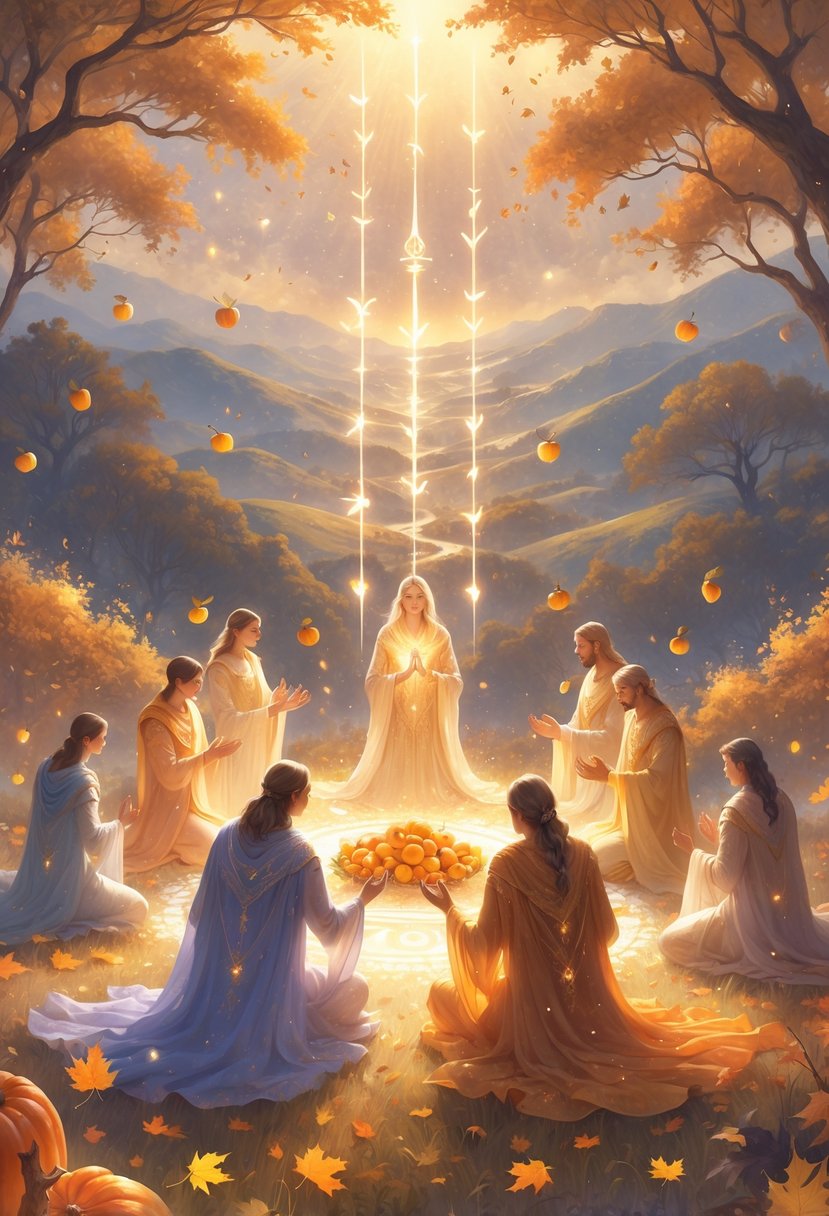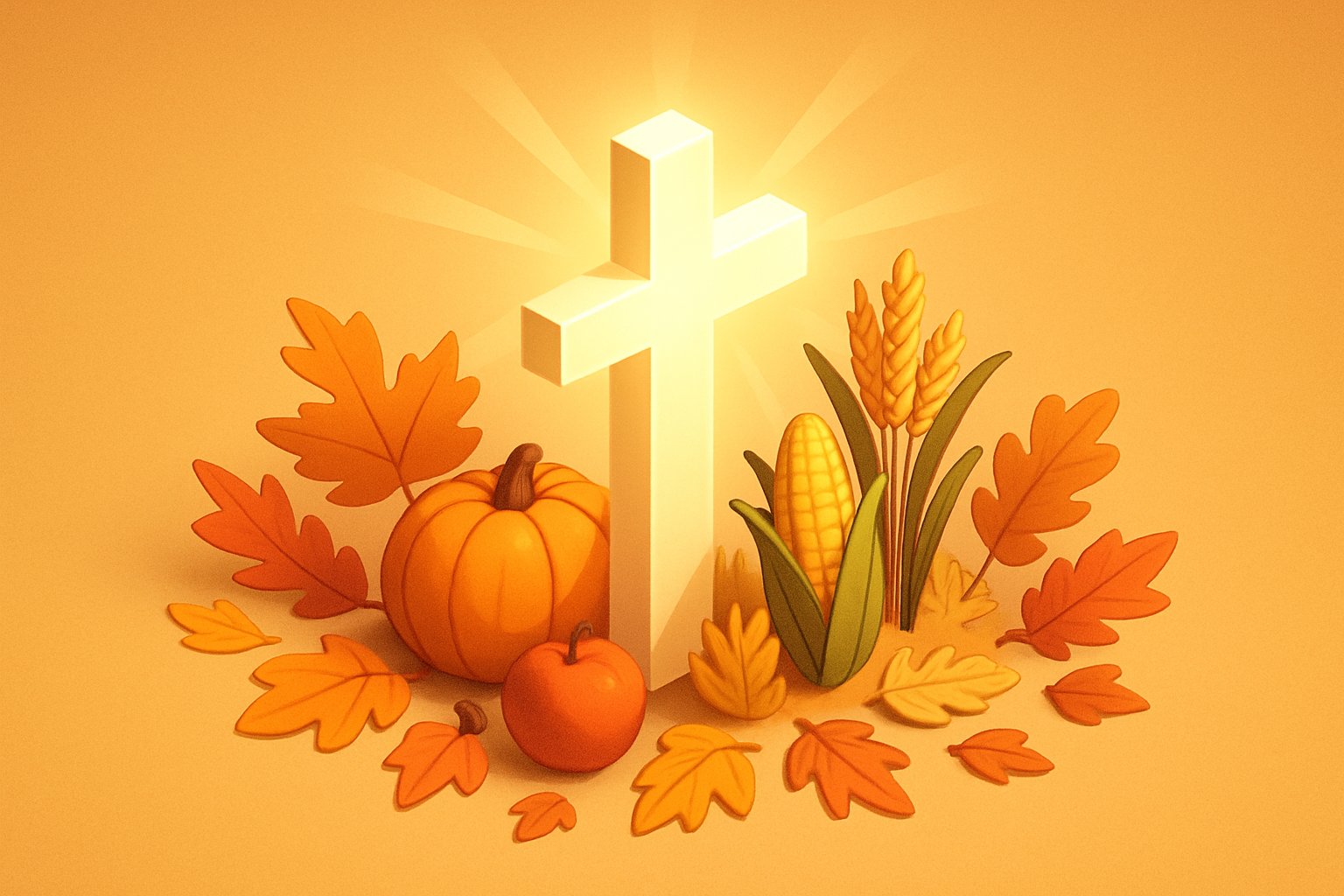The Spiritual Meaning of Thanksgiving

Thanksgiving isn’t just a holiday—it’s a chance to turn gratitude into something sacred. If you let it, the spiritual essence of gratitude can totally change how you experience life and connect with something greater.
Thanksgiving as a Sacred Practice
When you treat Thanksgiving as more than just a big meal, you step into deeper spiritual territory. That shift can change how you feel about gratitude all year long.
Daily Gratitude Rituals work wonders. Maybe you start your day by naming three blessings, or you look back each night to notice moments of grace you might’ve missed.
If you create a sacred space during Thanksgiving, that can really enhance your spiritual connection. Light a candle at the table or share a few moments of silence—little things like that invite something divine into your celebration.
Why keep it to November? You can bring thanksgiving spiritual meaning into every season with simple appreciation rituals.
Gratitude journaling opens your eyes to daily miracles. Write down what brings you joy—get specific. You’ll probably notice your perspective shifting toward abundance.
When families and friends share what they’re thankful for, community gratitude creates a kind of collective spiritual energy. It’s hard to describe, but you can feel it in the room.
Historical and Cultural Roots
Thanksgiving’s spiritual roots run deep—way deeper than the modern version. If you look back, you’ll find centuries of tradition across all sorts of cultures.
Ancient harvest festivals honored divine provision and the changing seasons. Communities gathered to say thanks for getting through tough times, recognizing they depended on something bigger than themselves.
Native American traditions center gratitude around the Earth and all living things. Their ceremonies honored the web of life, teaching us to see our place in the bigger story.
Early American Thanksgiving blended European Christian customs with indigenous wisdom. Colonists actually learned gratitude practices from Native peoples, who saw thanksgiving as an ongoing spiritual relationship.
Religious traditions worldwide weave in gratitude:
- Christian: Harvest festivals and communion
- Jewish: Sukkot and daily blessings
- Islamic: Prayers of thanks five times a day
- Buddhist: Merit dedication and appreciation
These roots show that cultivating gratitude and connection goes way beyond any single tradition. Your own practice ties you to this universal human urge to appreciate.
The Spiritual Essence of Gratitude
Gratitude isn’t just a nice feeling—it’s a spiritual force that changes you from the inside out. When you really get that, thanksgiving becomes a daily spiritual practice, not just a once-a-year thing.
Energetic shifts happen when you truly feel grateful. Your energy lifts, and you start noticing more good things coming your way. Maybe that sounds a little out there, but honestly, it’s something you can observe.
Gratitude opens your heart to receive more love. When you appreciate what you have, you make room for more blessings to find you. Funny how that works.
The spiritual essence means recognizing interconnection. You start seeing how everything in your life is linked by invisible threads of support.
Healing power comes through gratitude. When you focus on what you appreciate instead of what’s wrong, old wounds start to heal. Resentment just can’t stick around when gratitude is in the room.
Your relationships shift, too. Instead of picking at flaws, you see what others bring to your life—and that’s a game changer.
Signs of spiritual abundance show up more often when you keep your heart open. You start noticing synchronicities, unexpected kindness, and little moments of grace you might’ve missed before.
Gratitude as a Path to Spiritual Growth

Gratitude can totally change your spiritual journey. When you cultivate gratitude as a spiritual practice, you notice life’s blessings more and feel closer to the sacred.
Power of Gratitude
Gratitude isn’t just about being polite. It acts as a spiritual force that can deepen your relationship with the divine and even shape who you become.
Spiritual Benefits of Gratitude:
- Heightened awareness of blessings
- Stronger sense of purpose
- Openness to guidance
- More wonder about life’s mysteries
Practice thankfulness regularly, and your mindset shifts from scarcity to abundance. You start seeing how gratitude reveals blessings you might’ve overlooked.
That awareness builds on itself. The more grateful you are, the more you notice reasons to be grateful. It’s like your spiritual eyes get sharper, and you spot divine presence all over the place.
Gratitude also boosts your spiritual energy. When you express real appreciation, you make room for more good things to flow in.
Practicing Gratitude Daily
Daily gratitude practice changes spiritual growth from a random thing to something steady. Try starting every morning by naming three things you really appreciate.
Simple Daily Practices:
- Morning gratitude meditation (5-10 minutes)
- Evening reflection on blessings
- Journaling before bed
- Thanking someone at meals
Gratitude journaling stands out for spiritual growth. Write down who or what brought you joy, and be specific. Details matter more than sweeping statements.
Instead of “I’m grateful for my family,” you might write, “I’m grateful for my daughter’s laugh when she saw the first snow today.” That kind of detail makes it real.
Gratitude journaling and mindful appreciation attract blessings and build strong spiritual roots. Your words become little prayers, whether you realize it or not.
Try weaving gratitude into daily routines. Thank the earth for your food. Appreciate the sun’s warmth. Even just noticing the air you breathe counts.
Gratitude and Inner Peace
Practicing gratitude brings a surprising amount of inner peace. It shifts your focus from what’s missing to what’s already here. This helps you feel calmer and more centered.
When you regularly notice life’s gifts, anxiety and worry tend to fade. Your mind stops spinning on future problems or old regrets so much.
How Gratitude Creates Peace:
- Cuts down on mental noise about problems
- Brings you into the present
- Softens emotional reactivity
- Opens your heart to love
Thankfulness acts like spiritual medicine for restlessness. During rough patches, gratitude helps you find your footing.
Even small moments of appreciation ripple out as peace. Notice how your shoulders drop when you feel truly thankful.
This kind of tranquility lays the groundwork for deeper spiritual experiences. When your mind is at ease, it’s easier to sense guidance and presence.
Reflection, Mindfulness, and Introspection

Thanksgiving gives you a chance to pause and look inward, making space for mindful awareness and honest self-reflection. These practices can turn the holiday into something much deeper.
Cultivating Mindfulness
Mindfulness at Thanksgiving means actually paying attention to the moment. Try savoring each bite, noticing flavors and textures instead of rushing through the meal.
Simple mindful practices:
- Take three deep breaths before eating
- Listen to conversations without judging
- Feel gratitude for each person
- Notice the sounds, smells, and sights around you
Buddhist gratitude practices encourage mindful appreciation through meditation and being present. You might try five minutes of silence before your meal to see what shifts.
Mindful awareness doesn’t stop at the table. Go for a walk and notice nature. Even washing dishes can become a spiritual act if you focus on the warmth of the water or the feel of each plate.
Introspective Thanksgiving Rituals
Creating rituals adds depth and encourages honest self-reflection. These help you look at your growth, challenges, and blessings from the year.
Introspective rituals worth trying:
| Ritual | Duration | Purpose |
|---|---|---|
| Gratitude journaling | 15 minutes | Document specific blessings |
| Silent reflection | 10 minutes | Process emotions and experiences |
| Letter to future self | 20 minutes | Set intentions and goals |
You could build a thanksgiving altar with objects that mean something to you—photos, stones, or mementos of challenges you’ve overcome.
Evening reflection works well, too. Light a candle, then ask yourself what lessons the year brought. Who brought you joy? Which areas need more love or attention?
Benefits of Reflection
When you reflect regularly during Thanksgiving, you start to see real, lasting shifts in your spiritual well-being. These practices help you tune in to your own thoughts and emotions, nudging you toward a deeper sense of self-understanding.
Key benefits include:
- Enhanced emotional awareness – You start to notice patterns in how you react.
- Improved decision-making – Quiet contemplation brings clarity you might not expect.
- Stronger relationships – Knowing yourself better makes it easier to connect with others.
- Increased gratitude – Regular reflection uncovers blessings you may have missed before.
Your reflection practice can help you build resilience for whatever comes next. When you look at how you respond to challenges, you find better ways to cope.
This kind of introspection can reveal your real values and priorities. You get a clearer sense of what really matters to you, not just what society says should matter.
That clarity shapes your choices as the year unfolds. Honestly, isn’t that what we’re all hoping for?
Abundance, Prosperity, and Thankfulness

Thanksgiving can reveal signs of abundance and prosperity in tiny, everyday moments—a gentle breeze, a kind word, a smile from someone passing by. Real prosperity isn’t just about stuff; it’s about health, mental well-being, and the energy that comes from steady gratitude.
Recognizing Abundance in Daily Life
You might spot abundance in the smallest things. A hot cup of coffee, sunlight through your window, or an unexpected text from a friend—all these are little signals that prosperity is already here.
Physical signs of abundance can show up as more energy or feeling healthier. Gratitude seems to fuel your body in quiet but powerful ways.
Emotional abundance shows itself in moments of peace, contentment, and those rare flashes of joy. These feelings are proof that prosperity is flowing, even if the outside world feels hectic.
Nature constantly reminds us of abundance. Changing seasons, blooming flowers, even rain—these cycles are generous in their own right.
Your relationships also bring abundance. Time spent with loved ones, laughter, and honest conversations—these are forms of wealth you just can’t buy.
Daily abundance checklist:
- Notice three beautiful things each morning.
- Feel grateful for what your body can do.
- Appreciate kindness from others.
- Recognize moments of peace and calm.
Signs of Prosperity
Prosperity shows up in ways that really have nothing to do with your bank account. Sometimes you notice synchronicities or coincidences that seem to nudge you in the right direction.
Financial prosperity signs might look like unexpected money, new chances, or just feeling secure that your basic needs are met. These are hints that your relationship with abundance is on the upswing.
Your mental state can reveal prosperity too—clarity, focus, and bursts of creativity all count. When ideas come easily and problems seem less daunting, that’s a kind of wealth.
Physical prosperity shows up as good health, better sleep, and a steady flow of energy. Gratitude really does help your body thrive.
Social prosperity means having meaningful connections, real friendships, and chances to help others. These relationships add richness to your life that money just can’t match.
Key prosperity indicators:
- Opportunities popping up naturally
- Improved sleep and physical well-being
- Deeper relationships and connections
- Mental clarity and creative flow
Thankfulness in Challenging Times
Practicing thankfulness when things get tough can totally change how you see hardship. Even during rough patches, you can find real reasons to feel grateful.
Small blessings stand out more when times are hard. Clean water, a safe place to sleep, or just one supportive person—these are huge forms of abundance.
Challenges can reveal your inner strength and resilience—qualities that only grow stronger through adversity.
Gratitude practices for hard times:
- Write down one blessing every day.
- Thank your body for making it through tough days.
- Appreciate anyone who shows you kindness.
- Notice what you’re learning from the experience.
If you embrace forgiveness and let go of negative emotions, you open up space for new blessings.
Honestly, tough seasons can set you up for more abundance down the road. The skills and wisdom you pick up during hard times become the tools you use to grow later.
Connection, Community, and Belonging

Thanksgiving is a chance to strengthen relationships through shared meals and real conversations. The holiday highlights how our lives weave together, building support networks that go way beyond just family.
The Role of Community Gatherings
Community gatherings at Thanksgiving become sacred spaces where relationships deepen and new ones begin. When you show up for these moments, you add to the collective energy that lifts everyone.
Traditional gathering activities—potlucks, neighborhood parties, volunteering—let you see how community bonds form between all kinds of people.
Your presence at these events matters, sometimes more than you think. Every conversation, laugh, or helping hand adds to the spirit of togetherness.
Local organizations host special Thanksgiving events, opening their doors to anyone looking for connection. Churches, community centers, and cultural groups become places where you can feel at home, no matter your circumstances.
Building a Sense of Belonging
Belonging happens when you feel seen and valued by a group. Thanksgiving gives you a real shot at building these connections through simple acts of inclusion and hospitality.
Ways to foster belonging:
- Invite new neighbors to join your celebrations.
- Share family traditions with friends.
- Really listen to others’ stories.
- Offer help with meal prep.
- Make space for different perspectives.
When you help others feel welcome, you directly shape their sense of connection. Even small gestures—like asking about someone’s background or remembering a detail from last year—show you care.
Seeing how we’re all connected makes you appreciate shared experiences more. Your actions ripple out, touching the whole community.
Interconnectedness of All Beings
The spiritual side of Thanksgiving shows just how connected we all are, whether we realize it or not. When you notice these invisible threads linking you to others, gratitude comes more naturally.
Your food connects you to farmers, drivers, store clerks—so many hands make your meal possible. Suddenly, dinner becomes a celebration of human cooperation.
Levels of interconnection:
- Personal ties with family and friends
- Community bonds through shared spaces
- Global connections via food, culture, resources
- Environmental links to nature and the seasons
Everyone at your Thanksgiving table brings their own stories and wisdom. When you’re open to these connections, you open the door to deeper understanding and compassion.
This recognition stretches beyond people—it includes gratitude for the earth, animals, and natural systems that sustain us all.
Compassion, Empathy, and Generosity

Thanksgiving naturally opens your heart to deeper connections. You start to understand where others are coming from, show kindness without judging, and share what you have in ways that actually matter.
Cultivating Compassion During Thanksgiving
Compassion starts when you remember that everyone’s carrying something—especially at the holidays. Some family members might be grieving, struggling financially, or dealing with health or relationship issues.
Practice compassion by listening, without jumping in to fix everything. Just being there with someone’s pain can be healing. Sometimes, you need to put your own agenda aside to really hear what others need.
Active compassion shows up in little actions—helping with meal prep, cleaning up, or making space for quieter family members. These gestures speak volumes.
Don’t forget to show compassion to yourself, too. If family gatherings bring up stress or old wounds, treat yourself with the same kindness you’d give a friend. Nobody gets it perfect.
The Practice of Empathy
Empathy means trying to feel what someone else is feeling, without losing your own sense of self. At Thanksgiving, you can practice this by watching for relatives who seem withdrawn or sad.
Notice body language—slumped shoulders, forced smiles. These usually mean someone wants connection but isn’t sure how to ask.
Develop empathy by asking gentle questions. Even a simple, “How’s this year been for you?” can open up real conversation. The trick is listening to understand, not just to answer.
Empathetic responses validate feelings without trying to fix them. Saying, “That sounds tough” or “I can see why you’d feel that way” helps create emotional safety.
Practicing gratitude and mindful reflection can help you stay grounded while connecting with others’ emotions.
Acts of Generosity and Service
Generosity at Thanksgiving isn’t just about gifts. It’s about sharing your time, attention, and resources. Maybe you volunteer at a food bank or shelter, or invite someone who’d otherwise be alone.
That simple act of inclusion can change both your celebration and theirs. It’s worth considering.
Service opportunities during Thanksgiving might look like:
- Delivering meals to elderly neighbors
- Donating warm clothes to shelters
- Helping single parents with childcare
- Supporting a local food drive
Your generosity can be emotional, too. Compliment someone, thank them for their efforts, or share a good memory. These are gifts money can’t buy.
Sharing your blessings makes them even sweeter and builds connections that last long after the holiday.
Forgiveness and Spiritual Renewal

Thanksgiving gives you a chance to open your heart, let go of old hurts, and find healing through forgiveness. This time of year invites you to release resentments that weigh you down and discover how spiritual renewal can change everything.
Letting Go of Grudges
When you hold onto grudges, you build emotional barriers that get in the way of spiritual growth. These resentments feel like heavy chains, stopping you from truly feeling peace and joy, especially during Thanksgiving.
The Weight of Resentment
- Anger drains your mental energy.
- Bitterness clouds how you see things.
- Hurt feelings block your spirit.
Your spiritual journey gets clearer when you choose to let go of these burdens. Letting go doesn’t mean you excuse what happened—it just means you stop carrying the weight of someone else’s mistakes.
Try acknowledging your pain without judging yourself for it. Jot down your grievances, then burn or bury the paper as a symbolic way of releasing them. This little ritual nudges your subconscious to understand you’re ready to move on.
When you think about the person who hurt you, try to see them as someone dealing with their own pain. This shift in perspective doesn’t erase your experience, but it might open up a bit of compassion in your heart.
Embracing Forgiveness
Forgiveness really can change you from the inside out. It’s not about pretending nothing happened or forcing yourself to forget. Real forgiveness is about choosing peace instead of letting pain run the show.
Start with forgiving yourself. Maybe you carry guilt over things you wish you’d done differently, or regret about missed chances. Offering yourself compassion makes it easier to extend grace to others.
Here’s a simple forgiveness meditation you can try:
- Sit quietly, take a few deep breaths.
- Picture the person you want to forgive.
- Send them a little mental loving-kindness.
- Let go of any expectations about how they might respond.
Keep in mind, forgiveness isn’t a one-time thing. Some hurts take a few rounds to release. Be gentle with yourself as you work through those layers.
Embracing forgiveness can ease your stress, improve your relationships, and deepen your spiritual connections. Your heart opens up to more love and gratitude—honestly, who couldn’t use a bit more of that?
Spiritual Renewal and Healing
Thanksgiving gives you the perfect chance to find spiritual renewal through forgiveness. This kind of healing wakes up your soul and reconnects you to something bigger, something loving.
Create a sacred space for your renewal. Light a candle, play some music, or just step outside for a bit. These settings help support your spiritual journey toward feeling whole again.
Daily Renewal Practices:
- Say a gratitude prayer in the morning.
- Write a reflection journal at night.
- Practice mindful breathing.
- Do something kind for someone else.
Your spirit naturally starts to heal when you lean into forgiveness and gratitude. Old wounds might even turn into wisdom instead of just pain. You might surprise yourself with the strength you find.
Embracing forgiveness and release is honestly a gift you give yourself this season. The healing doesn’t just change your Thanksgiving—it shifts your whole outlook on life.
You’ll probably notice forgiveness makes room for new blessings. A renewed spirit draws in better experiences and deeper connections. It’s wild how this change can ripple out and lift up everyone around you.
Rituals, Intention Setting, and Personal Practice

Thanksgiving opens up so many chances to create spiritual meaning with simple rituals, focused intentions, and daily mindfulness. With a little effort, the holiday shifts from a routine gathering to something that feels deeply connected.
Thanksgiving Rituals That Deepen Spiritual Meaning
You can make sacred moments out of Thanksgiving through simple rituals that dig into the heart of gratitude. Treating Thanksgiving as a gratitude ritual lets you tap into a kind of spiritual power that comes from shared appreciation.
Gratitude Circle Ritual: Gather everyone in a circle before the meal. Each person shares three blessings from the year—suddenly, the room feels charged with real appreciation.
Blessing the Meal: Take turns thanking the earth, the farmers, and the cooks for the food on your table. It makes the meal feel a little more sacred.
Memory Candle Lighting: Light candles for loved ones who’ve passed. This honors their presence and weaves them into your celebration.
Nature Gratitude Walk: Before coming inside, take a walk outdoors. Pick up a leaf or stone—let it remind you of the earth’s abundance.
Intention Setting for the Holiday
Setting intentions can turn Thanksgiving into a real opportunity for spiritual growth. Intentions for growth align your actions with what matters most to you.
Start your day quietly, thinking about what you want to nurture spiritually. Write down three intentions that focus on gratitude, connection, and personal development.
Gratitude Intentions: Decide to express appreciation more often in the coming year. Pick a few specific ways you’ll notice and acknowledge your blessings.
Connection Intentions: Set a goal to deepen your relationships—with family, friends, or even nature. Think about how you’ll make those connections richer.
Service Intentions: Make a plan to give back. Find a volunteer opportunity or brainstorm acts of kindness you’ll actually follow through on.
Tell someone you trust about your intentions. It helps to have a little accountability and support along the way.
Personal Spiritual Practices
Bringing Thanksgiving into daily life with devotionals, prayer, or meditation keeps gratitude alive long after the holiday. These personal practices help anchor that sense of thankfulness in your heart.
Gratitude Meditation: Spend 10-15 minutes just sitting quietly, breathing, and focusing on what you’re grateful for. Let those blessings fill your awareness.
Thanksgiving Journaling: Write down gratitude entries each day before and after Thanksgiving. Capture the moments, people, or experiences that spark appreciation.
Prayer Practice: Offer prayers of thanks that go beyond your own life—include the earth, your community, and the abundance that connects us all.
Mindful Eating: Eat slowly and really savor your food. Notice the flavors and appreciate the nourishment.
Try making a gratitude ritual part of your daily routine. Let thanksgiving become something you practice all year, not just once in November.
Journaling, Meditation, and Everyday Expressions of Gratitude

These spiritual practices turn gratitude from a fleeting seasonal feeling into something you can lean on year-round. Writing, mindfulness, and small daily acts of appreciation help build real, lasting connections to abundance and inner peace.
Gratitude Journaling
Gratitude journaling gives you a sacred space to connect with your inner self and jot down spiritual insights. It goes way beyond just listing daily events—your journal can hold prayers, intentions, and the deeper stuff that matters.
Start with simple daily entries. Pick three specific blessings each day. Write about what brought you joy, a moment of unexpected kindness, or a personal breakthrough.
Spiritual journaling lets you track your growth. Record insights from meditation, inspiration from nature, or conversations that stuck with you.
Over time, your journal becomes a tapestry of your spiritual evolution. Skimming old entries can help you spot patterns of abundance and notice blessings you might’ve missed.
Some helpful journaling techniques:
- Free writing—just let your thoughts flow without editing.
- Use specific prompts to dig into daily gratitude.
- Record dreams and look for spiritual meaning.
- Note synchronicities and those weird, meaningful coincidences.
Meditation for Thankfulness
Mindfulness meditation makes more room for gratitude. When you quiet your mind, you notice blessings and support you might have missed in the rush.
Start with five minutes of focused breathing. As your mind settles, bring to mind people, experiences, or opportunities you genuinely appreciate.
Gratitude meditation ideas:
- Do a body scan, appreciating each part for what it does.
- Try loving-kindness meditation focused on relationships.
- Walk slowly and notice nature’s gifts around you.
- Visualize blessings flowing into your life.
These practices build compassion and intuitive awareness. You start to pick up on subtle signs of spiritual guidance and support from the universe.
With regular meditation, it gets easier to access gratitude even when life gets tough. Appreciation shifts from something you think about to something you actually feel—deep down, connected, and real.
Expressing Gratitude Year-Round
When you express gratitude every day, you turn thanksgiving into something way bigger than a single holiday. It becomes a way of living—one that quietly spreads good vibes through your relationships and even out into your community.
Morning gratitude practices:
- Start your morning by thanking your body
- Take a second to appreciate the safety and comfort of your home
- Notice the possibilities waiting in the new day
Try sharing specific appreciation with your family, friends, or coworkers. Instead of just saying “thank you,” mention exactly how they’ve made a difference in your life—even if it feels a little awkward at first.
You can build small gratitude rituals around meals, bedtime, or even when the seasons change. Maybe light a candle and talk about what you’re grateful for, or drop a note in a family gratitude jar whenever something good happens.
Evening reflection questions:
- Did something unexpected make today a little brighter?
- Who stepped up with kindness or support?
- What challenge actually helped me grow, even if it was tough?
Trying out different gratitude practices can boost your well-being and deepen your connection to spiritual ideas. Honestly, showing up for it every day matters way more than how long you spend on it.
Follow us on Social Media!
I’m Nina, and I’m very passionate about spirituality. Exploring the depths of the soul and connecting with the divine has always been my source of inspiration. Join me on a journey of self-discovery and inner peace through my writing.

